Trumpet
This article needs additional citations for verification. (October 2019) |
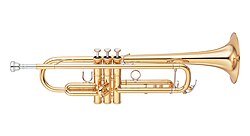 Trumpet in B♭ | |
| Brass instrument | |
|---|---|
| Classification | |
| Hornbostel–Sachs classification | 423.233 (Valved aerophone sounded by lip vibration) |
| Playing range | |
 | |
| Related instruments | |
|
alto horn, baritone horn, pocket trumpet | |
| Part of a series on |
Musical instruments |
|---|
The trumpet is a brass instrument commonly used in classical and jazz ensembles. The trumpet group ranges from the piccolo trumpet—with the highest register in the brass family—to the bass trumpet, pitched one octave below the standard B♭ or C trumpet.
Trumpet-like instruments have historically been used as signaling devices in battle or hunting, with examples dating back to at least 2000 BC.[1] They began to be used as musical instruments only in the late 14th or early 15th century.[2] Trumpets are used in art music styles, for instance in orchestras, concert bands, and jazz ensembles, as well as in popular music. Sound is produced by vibrating the lips in a mouthpiece,[3] which starts a standing wave in the air column of the instrument. Since the late 15th century, trumpets have primarily been constructed of brass tubing, usually bent twice into a rounded rectangular shape.
There are many distinct types of trumpet, with the most common being pitched in B♭ (a transposing instrument), having a tubing length of about 1.48 m (4 ft 10 in). Early trumpets did not provide means to change the length of tubing, whereas modern instruments generally have three (or sometimes four) valves in order to change their pitch. Most trumpets have valves of the piston type, while some have the rotary type. The use of rotary-valved trumpets is more common in orchestral settings (especially in German and German-style orchestras), although this practice varies by country. A musician who plays the trumpet is called a trumpet player or trumpeter.[4]
Etymology
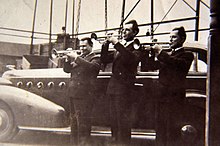
The English word trumpet was first used in the late 14th century.[5] The word came from Old French trompette, which is a diminutive of trompe.[5] The word trump, meaning trumpet, was first used in English in 1300. The word comes from Old French trompe 'long, tube-like musical wind instrument' (12c.), cognate with Provençal tromba, Italian tromba, all probably from a Germanic source (compare Old High German trumpa, Old Norse trumba 'trumpet'), of imitative origin."[6]
History

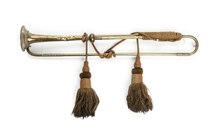
The earliest trumpets date back to 2000 BC and earlier. The bronze and silver Tutankhamun's trumpets from his grave in Egypt, bronze lurs from Scandinavia, and metal trumpets from China date back to this period.[7] Trumpets from the Oxus civilization (3rd millennium BC) of Central Asia have decorated swellings in the middle, yet are made out of one sheet of metal, which is considered a technical wonder for its time.[8]
The Salpinx was a straight trumpet 62 inches (1,600 mm) long, made of bone or bronze. Homer’s Iliad (9th or 8th century BCE) contain the earliest reference to its sound and further, frequent descriptions are found throughout the Classical Period.[9] Salpinx contests were a part of the original Olympic Games.[10] The Shofar, made from a ram horn and the Hatzotzeroth, made of metal, are both mentioned in the Bible. They were said to have been played in Solomon's Temple around 3,000 years ago. They are still used on certain religious days.[10]
The

Improvements to instrument design and metal making in the late Middle Ages and Renaissance led to an increased usefulness of the trumpet as a musical instrument. The natural trumpets of this era consisted of a single coiled tube without valves and therefore could only produce the notes of a single overtone series. Changing keys required the player to change crooks of the instrument.[10] The development of the upper, "clarino" register by specialist trumpeters—notably Cesare Bendinelli—would lend itself well to the Baroque era, also known as the "Golden Age of the natural trumpet." During this period, a vast body of music was written for virtuoso trumpeters. The art was revived in the mid-20th century and natural trumpet playing is again a thriving art around the world. Many modern players in Germany and the UK who perform Baroque music use a version of the natural trumpet fitted with three or four vent holes to aid in correcting out-of-tune notes in the harmonic series.[13]
The melody-dominated homophony of the classical and romantic periods relegated the trumpet to a secondary role by most major composers owing to the limitations of the natural trumpet. Berlioz wrote in 1844:
Notwithstanding the real loftiness and distinguished nature of its quality of tone, there are few instruments that have been more degraded (than the trumpet). Down to
Mozart – persisted in confining it to the unworthy function of filling up, or in causing it to sound two or three commonplace rhythmical formulae.[14]
Construction

The trumpet is constructed of
The mouthpiece has a circular rim, which provides a comfortable environment for the lips' vibration. Directly behind the rim is the cup, which channels the air into a much smaller opening (the back bore or shank) that tapers out slightly to match the diameter of the trumpet's lead pipe. The dimensions of these parts of the mouthpiece affect the timbre or quality of sound, the ease of playability, and player comfort. Generally, the wider and deeper the cup, the darker the sound and timbre.

Modern trumpets have three (or, infrequently, four)
The overall pitch of the trumpet can be raised or lowered by the use of the tuning slide. Pulling the slide out lowers the pitch; pushing the slide in raises it. Pitch can be "bent" using the embouchure only.[16]
To overcome the problems of intonation and reduce the use of the slides, Renold Schilke designed the tuning-bell trumpet. Removing the usual brace between the bell and a valve body allows the use of a sliding bell; the player may then tune the horn with the bell while leaving the slide pushed in, or nearly so, thereby improving intonation and overall response.[17]
A trumpet becomes a
Trumpets can be constructed from other materials, including plastic.[19]
Types


The most common type is the B♭ trumpet, but A, C, D, E♭, E, low F, and G trumpets are also available. The C trumpet is most common in American orchestral playing, where it is used alongside the B♭ trumpet.

The smallest trumpets are referred to as
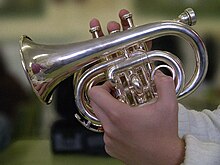

Trumpets pitched in the key of low G are also called sopranos, or soprano bugles, after their adaptation from military
The bass trumpet is at the same pitch as a trombone and is usually played by a trombone player,
The historical slide trumpet was probably first developed in the late 14th century for use in alta cappella wind bands. Deriving from early straight trumpets, the Renaissance slide trumpet was essentially a natural trumpet with a sliding leadpipe. This single slide was awkward, as the entire instrument moved, and the range of the slide was probably no more than a major third. Originals were probably pitched in D, to fit with shawms in D and G, probably at a typical pitch standard near A=466 Hz. No known instruments from this period survive, so the details—and even the existence—of a Renaissance slide trumpet is a matter of debate among scholars. While there is documentation (written and artistic) of its existence, there is also conjecture that its slide would have been impractical.[20]
Some slide trumpet designs saw use in England in the 18th century.[21]
The
The tubing of the bell section of a
David Monette designed the flumpet in 1989 for jazz musician Art Farmer. It is a hybrid of a trumpet and a flugelhorn, pitched in B♭ and using three piston valves.[22]
Other variations include rotary-valve, or German, trumpets (which are commonly used in professional German and Austrian orchestras), alto and
The trumpet is often confused with its close relative the
Playing
Fingering
On any modern trumpet, cornet, or flugelhorn, pressing the valves indicated by the numbers below produces the written notes shown. "Open" means all valves up, "1" means first valve, "1–2" means first and second valve simultaneously, and so on. The sounding pitch depends on the transposition of the instrument. Engaging the fourth valve, if present, usually drops any of these pitches by a perfect fourth as well. Within each overtone series, the different pitches are attained by changing the embouchure. Standard fingerings above high C are the same as for the notes an octave below (C♯ is 1–2, D is 1, etc.).
Each overtone series on the trumpet begins with the first overtone—the fundamental of each overtone series cannot be produced except as a pedal tone. Notes in parentheses are the sixth overtone, representing a pitch with a frequency of seven times that of the fundamental; while this pitch is close to the note shown, it is flat relative to equal temperament, and use of those fingerings is generally avoided.
The fingering schema arises from the length of each valve's tubing (a longer tube produces a lower pitch). Valve "1" increases the tubing length enough to lower the pitch by one whole step, valve "2" by one half step, and valve "3" by one and a half steps.[23] This scheme and the nature of the overtone series create the possibility of alternate fingerings for certain notes. For example, third-space "C" can be produced with no valves engaged (standard fingering) or with valves 2–3. Also, any note produced with 1–2 as its standard fingering can also be produced with valve 3 – each drops the pitch by 1+1⁄2 steps. Alternate fingerings may be used to improve facility in certain passages, or to aid in intonation. Extending the third valve slide when using the fingerings 1–3 or 1-2-3 further lowers the pitch slightly to improve intonation.[24]
Some of the partials of the
Mutes

Various types of mutes can be placed in or over the bell, which decreases volume and changes timbre.
Mutes can be made of many materials, including fiberglass, plastic, cardboard, metal, and "stone lining", a trade name of the Humes & Berg company.[30] They are often held in place with cork.[26][31] To better keep the mute in place, players sometimes dampen the cork by blowing warm, moist air on it. [26]
The straight mute is conical and constructed of either metal (usually aluminum[27])—which produces a bright, piercing sound—or another material, which produces a darker, stuffier sound.[32][33] The cup mute is shaped like a straight mute with an additional, bell-facing cup at the end, and produces a darker tone than a straight mute.[34] The harmon mute is made of metal (usually aluminum or copper[27]) and consists of a "stem" inserted into a large chamber.[34] The stem can be extended or removed to produce different timbres, and waving one's hand in front of the mute produces a "wah-wah" sound, hence the mute's colloquial name.[34]
Range
Using standard technique, the lowest note is the written F♯ below
below the low F♯, which is a device occasionally employed in the contemporary repertoire for the instrument.Extended technique
Contemporary music for the trumpet makes wide uses of extended trumpet techniques.
Growling: Simultaneously playing tone and using the back of the tongue to vibrate the uvula, creating a distinct sound. Most trumpet players will use a plunger with this technique to achieve a particular sound heard in a lot of Chicago Jazz of the 1950s.
Triple tonguing: The same as double tonguing, but with the syllables ta-ta-ka ta-ta-ka ta-ta-ka.
Doodle tongue: The trumpeter tongues as if saying the word doodle. This is a very faint tonguing similar in sound to a valve tremolo.
Glissando: Trumpeters can slide between notes by depressing the valves halfway and changing the lip tension. Modern repertoire makes extensive use of this technique.
Vibrato: It is often regulated in contemporary repertoire through specific notation. Composers can call for everything from fast, slow or no vibrato to actual rhythmic patterns played with vibrato.
Pedal tone: Composers have written notes as low as two-and-a-half octaves below the low F♯ at the bottom of the standard range. Extreme low pedals are produced by slipping the lower lip out of the mouthpiece. Claude Gordon assigned pedals as part of his trumpet practice routines, that were a systematic expansion on his lessons with Herbert L. Clarke. The technique was pioneered by Bohumir Kryl.[35]
Valve tremolo: Many notes on the trumpet can be played in several different valve combinations. By alternating between valve combinations on the same note, a tremolo effect can be created. Berio makes extended use of this technique in his Sequenza X.
Noises: By hissing, clicking, or breathing through the instrument, the trumpet can be made to resonate in ways that do not sound at all like a trumpet. Noises may require amplification.
Preparation: Composers have called for trumpeters to play under water, or with certain slides removed. It is increasingly common for composers to specify all sorts of preparations for trumpet. Extreme preparations involve alternate constructions, such as double bells and extra valves.
Split tone: Trumpeters can produce more than one tone simultaneously by vibrating the two lips at different speeds. The interval produced is usually an octave or a fifth.
Lip-trill or shake: Also known as "lip-slurs". By rapidly varying air speed, but not changing the depressed valves, the pitch can vary quickly between adjacent harmonic partials. Shakes and lip-trills can vary in speed, and in the distance between the partials. However, lip-trills and shakes usually involve the next partial up from the written note.
Multi-phonics: Playing a note and "humming" a different note simultaneously. For example, sustaining a middle C and humming a major 3rd "E" at the same time.
Circular breathing: A technique wind players use to produce uninterrupted tone, without pauses for breaths. The player puffs up the cheeks, storing air, then breathes in rapidly through the nose while using the cheeks to continue pushing air outwards.
Instruction and method books
One trumpet method is
Players
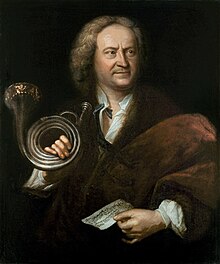
In early jazz,
Musical pieces
Solos
Anton Weidinger developed in the 1790s the first successful keyed trumpet, capable of playing all the chromatic notes in its range. Joseph Haydn's Trumpet Concerto was written for him in 1796 and startled contemporary audiences by its novelty,[45] a fact shown off by some stepwise melodies played low in the instrument's range.
In art
-
The Last Judgment (workshop of Hieronymus Bosch), c. 1500–1510
-
Trumpet-Player in front of a Banquet, Gerrit Dou, c. 1660–1665
-
Illustration forAesop's fables
-
Louis Armstrong statue in Algiers, New Orleans
-
Kielce, Poland
See also
References
Notes
- ^ White, H.N. (25 June 2023). "History of the Trumpet and Cornet". Trumpet-history.com. Retrieved 25 June 2023.
- ^ "History of the Trumpet (According to the New Harvard Dictionary of Music)". petrouska.com. Archived from the original on 8 June 2008. Retrieved 17 December 2014.
- ^ "Brass Family of Instruments: What instruments are in the Brass Family?". www.orsymphony.org. Retrieved 12 May 2020.
- ^ a b c Koehler 2013
- ^ a b "Trumpet". www.etymonline.com. Online Etymology Dictionary. Retrieved 20 May 2017.
- ^ "Trump". www.etymonline.com. Online Etymology Dictionary. Retrieved 20 May 2017.
- ^ Edward Tarr, The Trumpet (Portland, Oregon: Amadeus Press, 1988), 20–30.
- ^ "Trumpet with a swelling decorated with a human head," Musée du Louvre
- ^ Homer, Iliad, 18. 219.
- ^ a b c "History of the Trumpet | Pops' Trumpet College". Bbtrumpet.com. 8 November 2017. Retrieved 19 April 2021.
- Thames and Hudson, 1997.
- ^ "Chicago Symphony Orchestra – Glossary – Brass instruments". cso.org. Retrieved 3 May 2008.
- ISBN 978-0-300-11230-6.
- ^ Berlioz, Hector (1844). Treatise on modern Instrumentation and Orchestration. Edwin F. Kalmus, NY, 1948.
- ^ "Trumpet, Brass Instrument". dsokids.com. Retrieved 3 May 2008.
- ^ Blackwell, James (11 December 2012). "Pitch Bends!". Blackwells Trumpet Basics. Retrieved 26 June 2023.
- ^ Bloch, Dr. Colin (August 1978). "The Bell-Tuned Trumpet". Archived from the original on 25 December 2008. Retrieved 25 February 2010.
- ^ D. J. Blaikley, "How a Trumpet Is Made. I. The Natural Trumpet and Horn", The Musical Times, 1 January 1910, p. 15.
- ^ P-trumpet
- ^ "IngentaConnect More about Renaissance slide trumpets: fact or fiction?". ingentaconnect.com. Archived from the original on 22 September 2012. Retrieved 3 May 2008.
- ^
Lessen, Martin (1997). "JSTOR: Notes, Second Series". Notes. 54 (2): 484–485. JSTOR 899543.
- ISBN 978-0-253-01179-4. Retrieved 7 December 2017.
- OCLC 946032345.
- OCLC 472461178.
- ^ Schafer, Erika. "Trumpet Tuning Tendencies Relating to the Overtone Series with Solutions". UTC Trumpet Studio. Retrieved 19 January 2023.
- ^ a b c d Ely 2009, p. 109.
- ^ a b c d Ely 2009, p. 111.
- ^ For the "widest selection of mutes", see Sevsay 2013, p. 125.
- For the list of common mutes, see Ely 2009, p. 109.
- ISBN 978-1-56159-263-0. Retrieved 16 September 2020.
- ^ For the list of materials, see Ely 2009, p. 109.
- For the origin of "stonelined mutes", see Koehler 2013, p. 173.
- ^ Sevsay 2013, p. 125.
- ^ Sevsay 2013, p. 125: "plastic (fiberglass): not as forceful as the metal mute, a bit darker in color, but still penetrating"
- ^ Koehler 2013, p. 173.
- ^ a b c Sevsay 2013, p. 126.
- ^ Joseph Wheeler, "Review: Edward H. Tarr, Die Trompete" The Galpin Society Journal, Vol. 31, May 1978, p. 167.
- ISBN 0-8258-0385-3.
- ISBN 0-8258-0158-3.
- ^ Colin, Charles and Advanced Lip Flexibilities.[full citation needed]
- ^ "Allen Vizzutti Official Website". www.vizzutti.com. Retrieved 21 October 2016.
- ^ Franquin, Merri (2016) [1908]. Quinlan, Timothy (ed.). "Complete Method for Modern Trumpet". qpress.ca. Translated by Jackson, Susie.
- ^ Shamu, Geoffrey. "Merri Franquin and His Contribution to the Art of Trumpet Playing" (PDF). p. 20. Retrieved 11 August 2017.
- ^ West, Michael J. (3 November 2017). "The Cornet: Secrets of the Little Big Horn". JazzTimes.com. Retrieved 17 August 2018.
- ^ "Miles Davis, Trumpeter, Dies; Jazz Genius, 65, Defined Cool". nytimes.com. Retrieved 3 May 2008.
- ^ "Ferguson, Maynard". Encyclopedia of Music in Canada. The Canadian Encyclopedia. Retrieved 2 January 2008.
- ^ Keith Anderson, liner notes for Naxos CD 8.550243, Famous Trumpet Concertos, "Haydn's concerto, written for Weidinger in 1796, must have . At the first performance of the new concerto in Vienna in 1800 a trumpet melody was heard in a lower register than had hitherto been practicable."
Bibliography
- Barclay, R. L. (1992). The art of the trumpet-maker: the materials, tools, and techniques of the seventeenth [sic] and eighteenth centuries in Nuremberg. Oxford [England]: Clarendon Press. ISBN 0-19-816223-5.
- Bate, Philip (1978). The trumpet and trombone : an outline of their history, development, and construction (2nd ed.). London: E. Benn. ISBN 0-393-02129-7.
- Brownlow, James Arthur (1996). The last trumpet: a history of the English slide trumpet. Stuyvesant, N.Y.: Pendragon Press. ISBN 0-945193-81-5.
- Campos, Frank Gabriel (2005). Trumpet technique. Oxford: Oxford University Press. ISBN 0-19-516692-2.
- Cassone, Gabriele (2009). The trumpet book (1st ed.). Varese, Italy: Zecchini. ISBN 978-88-87203-80-6.
- Ely, Mark C. (2009). Wind talk for brass: a practical guide to understanding and teaching brass instruments. Oxford: Oxford University Press. ISBN 978-0-19-532924-7.
- English, Betty Lou (1980). You can't be timid with a trumpet: notes from the orchestra (1st ed.). New York: Lothrop, Lee & Shepard Books. ISBN 0-688-41963-1.
- Koehler, Elisa (2013). Dictionary for the modern trumpet player. Lanham, Maryland: Scarecrow Press. ISBN 978-0-8108-8658-2.
- Sherman, Roger (1979). The trumpeter's handbook: a comprehensive guide to playing and teaching the trumpet. Athens, Ohio: Accura Music. ISBN 0-918194-02-4.
- Sevsay, Ertuğrul (2013). The Cambridge guide to orchestration. New York: Cambridge University Press. p. 125. ISBN 978-1-107-02516-5.
- Smithers, Don L. (1973). The music and history of the baroque trumpet before 1721 (1st ed.). Syracuse, N.Y.: Syracuse University Press. ISBN 0-8156-2157-4.
External links
 The dictionary definition of trumpet at Wiktionary
The dictionary definition of trumpet at Wiktionary- . Encyclopædia Britannica. Vol. 27 (11th ed.). 1911.
- International Trumpet Guild, international trumpet players' association with online library of scholarly journal back issues, news, jobs and other trumpet resources.

![The Last Judgment (workshop of Hieronymus Bosch) [nl], c. 1500–1510](http://upload.wikimedia.org/wikipedia/commons/thumb/7/78/Workshop_of_Jheronimus_Bosch_001.jpg/120px-Workshop_of_Jheronimus_Bosch_001.jpg)



